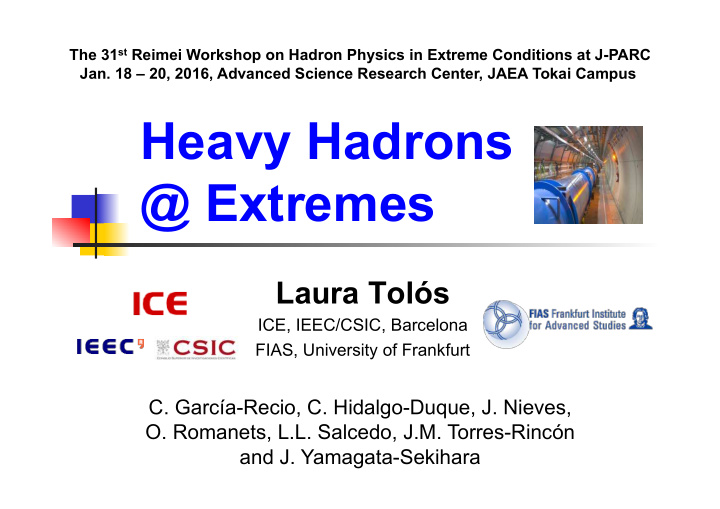



The 31 st Reimei Workshop on Hadron Physics in Extreme Conditions at J-PARC Jan. 18 – 20, 2016, Advanced Science Research Center, JAEA Tokai Campus Heavy Hadrons @ Extremes Laura Tolós ICE, IEEC/CSIC, Barcelona FIAS, University of Frankfurt C. García-Recio, C. Hidalgo-Duque, J. Nieves, O. Romanets, L.L. Salcedo, J.M. Torres-Rincón and J. Yamagata-Sekihara
Charm under Extreme Conditions J/ Ψ suppression D-mesic nuclei Gonin et al (NA50) ’96, Matsui and Satz ’86 Tsushima et al ’99, Garcia-Recio et al ’10 Garcia-Recio et al ’12 Yasui et al ’12, Yamagata-Sekihara ‘16.. 208 Pb _ D 0 ,D - ,D 0 taken from Hirano@CISS07 but also comover scattering _ J/ Ψ + π → D + D Capella, Ferreiro, Vogt, Wang, Bratkovskaya, Cassing, Andronic..
QMC model MF/RHF model Mazumdar, Mishra, Kumar,.. exchange of ω , ρ , σ mesons among quarks in a meson/baryon bag Tsushima, Tsuhima et al ‘98 Thomas, Kumra and Mishra ‘09 Sibirtsev, Mean-field or RHF approach to Fountoura.. effective lagrangian generalized to include charmed mesons QCD sum-rule π exchange Gubler, Hayashigaki, Hilger, Kaempfer, Leupold, Nielsen, Navarra, Oka, heavy meson Suzuki, Thomas, Weise, .. - nucleon operator product interaction expansion for in- mediated by medium correlation π exchange function and relate it to the spectral Yasui and Sudoh ‘13 Suzuki, Gubler and Oka ‘15 function
Unitarized theory in matter selfconsistent coupled-channel procedure (bare interaction saturated by t-channel vector-meson exchange) D + Mizutani and Ramos ‘06 Korpa and Lutz ‘06 Λ c (2595)N -1 Σ c (2800)N -1 Belle collaboration Lutz, Korpa, Hofmann.. Ramos, Mizutani, Jimenez-Tejero, Vidana, LT,. .
Meson-baryon interaction with heavy quarks: Incorporate Heavy-Quark Spin Symmetry HQSS*: spin interactions vanish for infinitely massive quarks *Isgur, Wise, Manohar, Neubert To construct a model for four flavors for pseudoscalar and vector mesons as well as 1/2 + and 3/2 + baryons that incorporates HQSS in the charm sector: extended WT interaction that fulfills SU(6)xHQSS and it is consistent with chiral symmetry in the light sector K(s): depends on meson-baryon energy f: decay constant = + H ex : exchange of quarks H’ ac : annhilation and creation of quark- antiquark pairs, corrected with HQSS constraints (only light quarks) T ij = V ij + V il G l T lj
Spectroscopy of excited charmed baryons coupling constant Λ c : C=1,S=0,I=0 Garcia-Recio et al.’09; mass and width Romanets et al. ’12 J=1/2 J=3/2 • Λ c (2595) has large DN and D*N components • Double-pole pattern for Λ c (2595), like for Λ (1405) • Identification of Λ c (2625)
Charmed hadrons in matter Unitarized theory in matter: selfconsistent coupled-channel procedure Free space = + potential from extended WT T ij = V ij + V il G l T lj interaction that meson dressing respect HQSS Medium = + Pauli blocking and baryon dressing T ij ( ρ , Τ ) = V ij + V il G l ( ρ , Τ ) T lj ( ρ , Τ ) Dressed meson: = + Π self-energy
Dynamically-generated PDG baryonic resonances in nuclear matter LT, Garcia-Recio and Nieves ‘10 [ α fitted to reproduce Λ c (2595) and analyze energies up to 3.5 GeV] Λ c (2595) Λ c (2941) Λ c (2625) Σ c (2800)
Unitarized theory in matter: selfconsistent coupled-channel procedure Simultaneous calculation of D and D* self-energies T=0 Σ * c (2800)N -1 Garcia-Recio et al ’09 Σ c N -1 LT et al. ‘10; Gamermann et al. ‘10 Λ c (2595)N -1 Λ * c N -1 Garcia-Recio et al. ‘10 Garcia-Recio et al.’12 Λ c (2595)N -1 Romanets et al. ’12 Garcia-Recio et al.(1) ‘13 Garcia-Recio et al.(2) ‘13
D mesic nuclei Initially predicted in 208 Pb within QMC model Tsushima et al. ‘99 Within the self-consistent coupled- channel approach that incorporates HQSS Garcia-Recio, Nieves, Salcedo and LT ‘10, ‘12 - Weakly bound D 0 -nucleus states with important widths in contrast to QMC model, while D + does not bind _ - D - and D 0 bind in nuclei
Formation spectra of charmed meson-nucleus using an antiproton beam 2p D - nuclear state @ J-PARC, PANDA (FAIR) Yamagata-Sekira, Garcia-Recio, Nieves, Salcedo and LT ‘16 Large momentum transfer (about 1 GeV/c) makes any structure due to bound states not noticeable. Need of reactions with lower momentum transfer, such as
D meson propagation in dense hot matter D-mesons: One of the cleanest probes of the early stages of the collision Fokker-Planck equation drag force diffusion coefficient Z | T | 2 d Ω ω ∝ Previous works Laine ‘11; He, Fries, Rapp ‘11; Ghosh, Das, Sarkar, -eAlam ’11 We need scattering amplitudes |T| 2 Abreu, Cabrera, Llanes-Estrada, Torres-Rincon ’11; LT and Torres-Rincon ’13
Some results for FAIR energies LT and Torres-Rincon ‘13 LT and Torres-Rincon ’13 energies 5-40 AGeV µ B =0 QGP hadrons Shorter relaxation time for lower energy beams (baryons!) but Continuous matching at T c do not relax ( τ fireball ~10 fm) Berrehrah et al. ‘14; Ozvenchuk et al ‘14
Beauty under Extreme Conditions Spectroscopy of excited beauty baryons Λ b (5912) and Λ * b (5920) found by LHCb* collaboration are described as meson- baryon molecular states belonging to a HQSS doublet. New HQSS partners are predicted: Ξ b (6035) and Ξ b (6043) * Aaij et al (LHCb) ‘12 Garcia-Recio, Nieves, Romanets, Salcedo and LT ‘13
_ B meson propagation in dense hot matter Fokker-Planck equation drag force diffusion coefficient Results from FAIR to RHIC energies Torres-Rincon, LT and Romanets ‘14 RHIC FAIR Bottom can hardly relax during expansion fireball ( τ fireball ~10 fm) Results insensitive to trajectory for high s/n B : prediction for behaviour of hadronic medium at RHIC energies
Summary � it is an exciting moment � moving from the light to the charm/beauty sector � a lot of theoretical effort is needed � but in close connection to experiments in laboratories
Recommend
More recommend